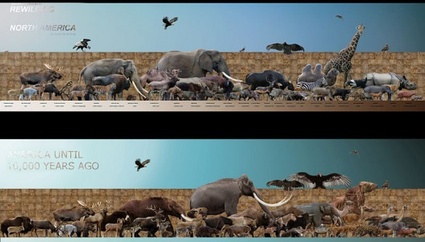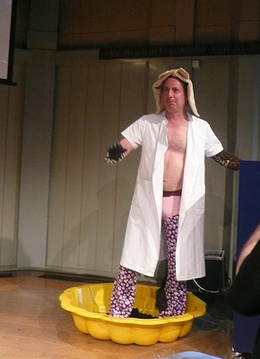 VASTAL, VivoArts School for Transgenic Aesthetics Ltd., is a temporary research and education institute that Adam Zaretsky has created in Amsterdam following an invitation by the Waag Society. Zaretsky, currently artist in residency at Waag, will give lectures and workshops on Art and Life Sciences. The School was born with the objective of showing the public what it means to work both artistically and scientifically with living organisms and materials. VASTAL also aims to make this form of art-science accessible for a broader audience and invite them to discuss the ethical and aesthetic issues at stake.
VASTAL, VivoArts School for Transgenic Aesthetics Ltd., is a temporary research and education institute that Adam Zaretsky has created in Amsterdam following an invitation by the Waag Society. Zaretsky, currently artist in residency at Waag, will give lectures and workshops on Art and Life Sciences. The School was born with the objective of showing the public what it means to work both artistically and scientifically with living organisms and materials. VASTAL also aims to make this form of art-science accessible for a broader audience and invite them to discuss the ethical and aesthetic issues at stake.
The May session are dedicated to EcoArt. September will focus on biology and bacterial transformation in particular. November will tackle embryology, zoology and body art. There will be labs and courses on hybrid DNA isolation, discussions on ethical issues, non-human relation explorations, but also radical food preparations and field trips to the slaughterhouse, the pet store and the zoo.
People tend to divide the world into separate categories: ecology, food, non-human species, body, etc. If you try and mix them together (in practice or theory, for example by asking questions such as “Do plants have feelings? Conscousness?”) , people get nervous. Yet the workshop is going to study these five topics one after the other and then mix blend together in the final session of the classes. I could only participate to the first day of the Eco Art session but i do intend to come back in September for the lectures and workshops on bio-ethic, bioart and DNA sequencing.
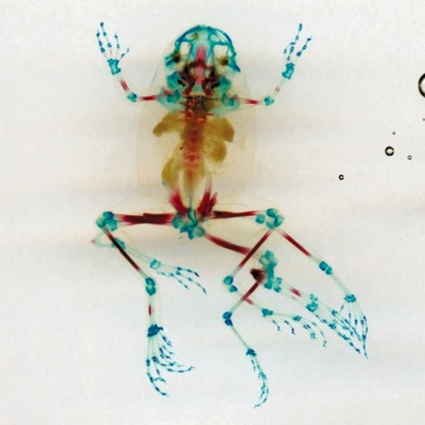 Brandon Ballengee, DFA 19, Io
Brandon Ballengee, DFA 19, Io
Scanner Photograph of Cleared and Stained Multi-limbed Pacific Tree frog from Aptos, California in Scientific Collaboration with Dr. Stanley K. Sessions. MALAMP titles in collaboration with the poet KuyDelair.
Courtesy the Artist and Archibald Arts, NYC
Private collection, London
Tomorrow Tuesday 26, Andy Gracie and Brandon Ballengée are going to give EcoArt lectures at 20.00 at Waag. This is going to be good, take my word for it.
Adam started the workshop by a lecture, reminding briefly a few points:
– Bio art has only just started existing. There’s no manifesto written by bio artists, just a desire to remind us that we are alive;
– Bio artists invite us to look behind the curtain of life;
– Engaging with life never comes without some controversy, whether you are an artist or a scientist;
– We need people who are not scientists, who do not work for corporations but who are creative individuals ready to get their hands ‘wet’ and dirty and shape their own opinion about the way scientific development is going to leave an imprint on our life.
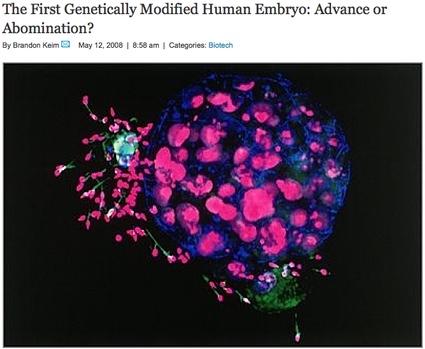 Screenshot from a Wired article
Screenshot from a Wired article
Adam recommended the reading of an essay he wrote back in for the CIAC’s magazine dedicated to Bioart. See also the Live skype talk he gave at the Retool the Earth conference in Brussels on October 2008.
That’s it for the quick intro on bioart. Then came a few words about the topic of this month at VASTAL: EcoArt. EcoArt is just another name for a series of practices that exist for decades. They have also be known as ecovention, land art, earthworks, environmental art, ecological art, etc. A great place to get an idea of the breath of projects that can be labeled as Ecoart is greenmuseum.org. Adam named a few of his favourite projects. One of them is Buster Simpson‘s Hudson River Purge. The performance addresses the problem of acid rain with giant limestone antacid tablets which neutralize the pH of the Hudson River. The river is like a gigantic human organism suffering acid indigestion, only a big pill will alleviate its pain. However, no matter the size of the pill, the source of the problem persists.
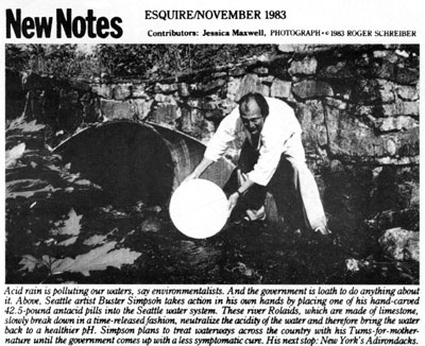 Hudson River Purge, New Notes, Esquire, November 1983. Photographer Roger Schreiber
Hudson River Purge, New Notes, Esquire, November 1983. Photographer Roger Schreiber
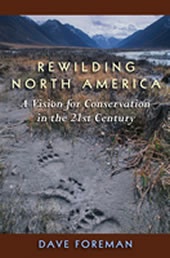 A book Adam found important for the reflection on our relationship to landscape and nature is Rewilding North America by Dave Foreman.
A book Adam found important for the reflection on our relationship to landscape and nature is Rewilding North America by Dave Foreman.
According to the book, the biggest ecological threat of our time is mass extinction of animal species caused by humans. Recent discoveries in conservation biology call for wildlands networks instead of isolated protected areas. The final section describes specific approaches for designing such networks (based on the work of the Wildlands Project.) A first step would be to re-introduce African and Asian megafauna in western North America – that includes lions, elephants, cheetahs, and camels- to create a facsimile of species that disappeared from the continent some 13,000 years ago. These large mammals need to roam and the parks and natural reserves humans have conceded them are clearly not sufficient. They need to get out of the borders. Wildlands Networks proposes to connects the parks together through corridors accessible for non-humans. Areas of shared use by humans and wildlife would have to be implemented as well as animals will inevitably run into shopping malls, golf courses and railways while migrating from one wild areas to another. We need to de-program ourselves from our own culture in order to be able to deal with this new kind of living conditions.
For the hands-on part of the course, Adam teamed up with Theun Karelse from FoAM & FoAM Lab Amsterdam. Our assignment of the day was to create sculptures made of earth, fertilizer, clay and seeds and distribute them throughout the city of Amsterdam.
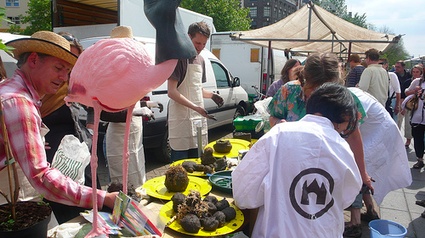
The workshop is in fact inspired by the practice of seedballing that aims to return native and often vanished flora species to cities and suburbia. The most eco-friendly version of seedball, developed by Masanobu Fukuoka, consists in mud-and-clay balls that contain a mixture of organic compost and different seed species meant to complement each other.
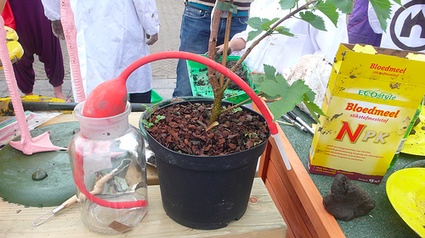 Key ingredients included bone powder and blood flour
Key ingredients included bone powder and blood flour
We set up our working space right in the middle of the organic market on the Nieuwmarkt.
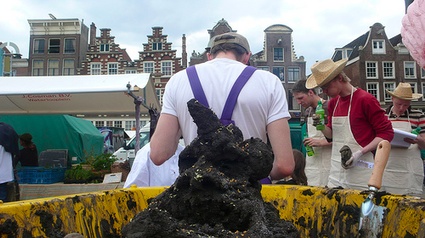
Adam, Lucas and Lipika from Waag kicked off their shoes and mixed the clay, fertilizer and seeds with their feet wine stomping-style while the rest of us started making sculptures and rolling little balls. Almost immediately people came to us, asking what we were doing, putting on gloves and helping us shape seed balls.
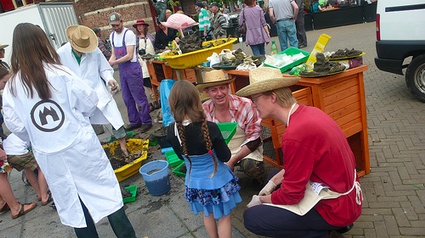 Enrolling passersby
Enrolling passersby
Once we had collected enough seed balls we went on a guerrilla gardening walk to spread them in the city in places where they might thrive. The workshop was actually a crash version of seedballing as the balls should be left to dry for a couple of days before being released in the urban wilderness. When the rains come, the mud and clay will break apart, exposing the seeds to elements that lead to their growth. In each location whichever seeds are best suited thrive in their protected mud starter-home.
The ‘seedballed’ sites will then be mapped by Theun and added to google maps of urban edibles.
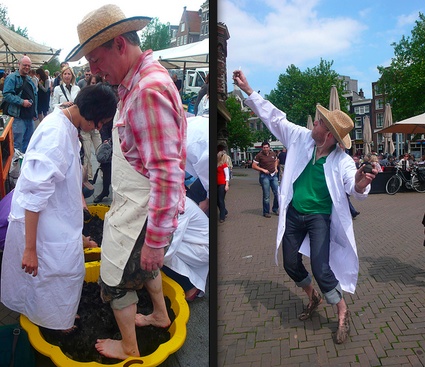
The workshop was a great success, its simplicity attracted all sorts of passersby and the majority of them were happy to go pass the fun of seeing us getting covered in mud and enter a more in-depth and meaningful conversation.
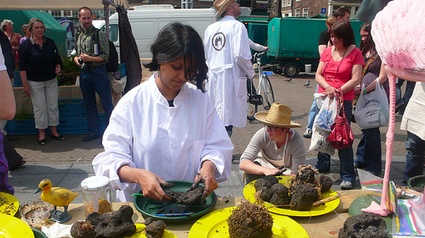
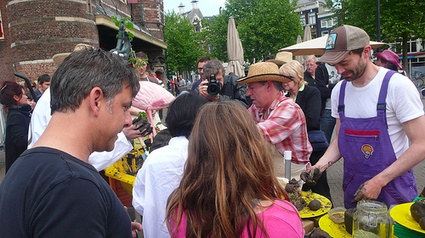
Here’s my flickr set of the event.
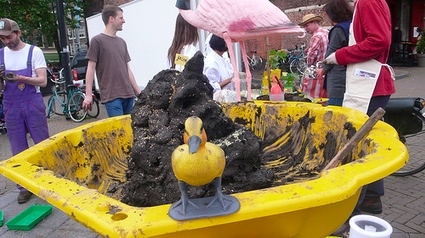
Related stories: How to Save the World in 10 Days at Vooruit in Ghent, Dangerous Liaisons and other stories of transgenic pheasant embryology.

